Address
304 North Cardinal St.
Dorchester Center, MA 02124
Work Hours
Monday to Friday: 7AM - 7PM
Weekend: 10AM - 5PM
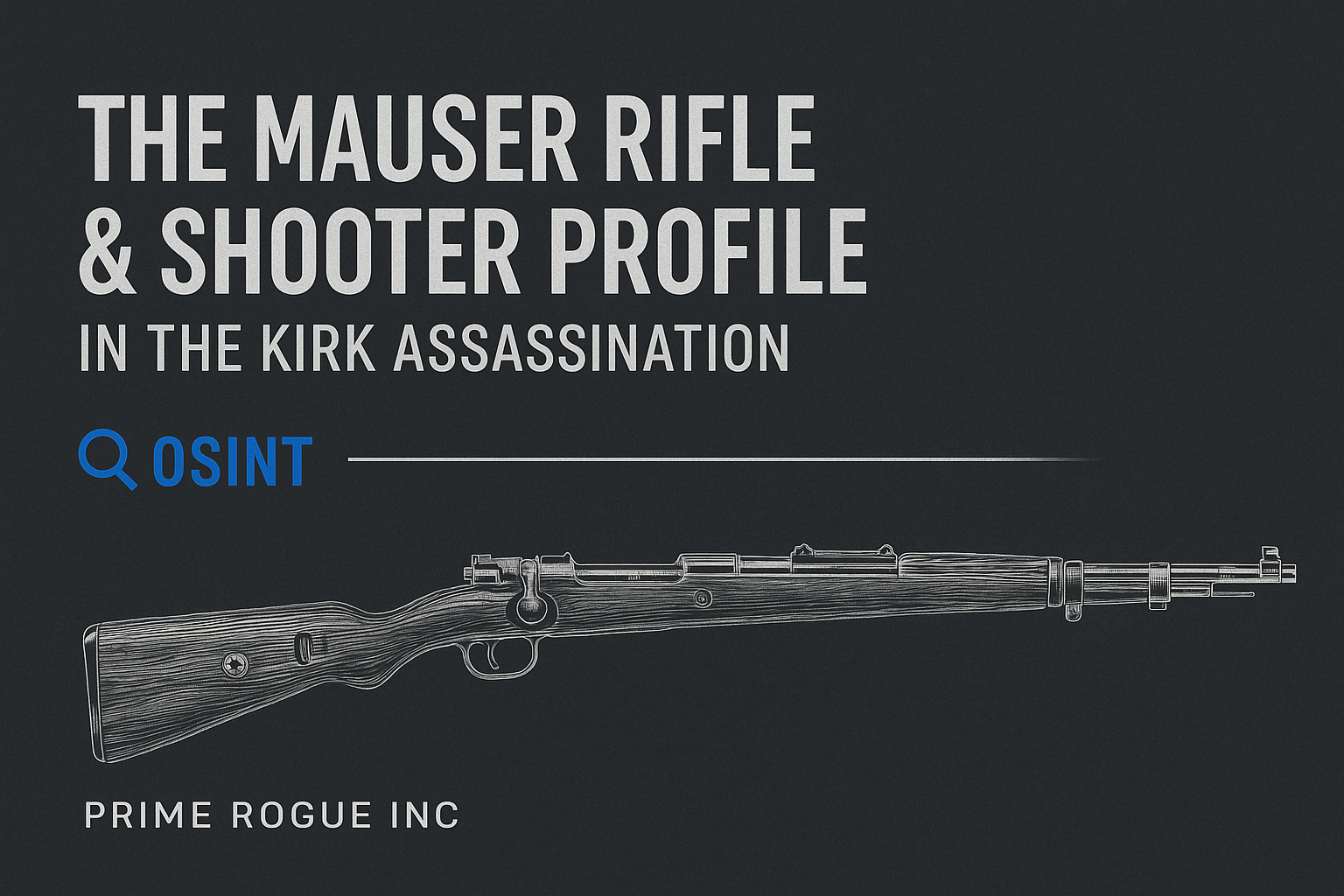
In our prior analysis “The One-Shot Assassination Anomaly,” we noted how extraordinary it is for a single rifle round to alter political history. Now, as a follow-up, we turn to the recovered Mauser .30-06 bolt-action rifle from the Charlie Kirk assassination. This piece examines what that weapon choice reveals about the shooter’s capabilities and intent, and how this detail is being interpreted across investigative and public narratives. Our approach is rooted in OSINT rigor – separating confirmed facts from plausible inference and contested claims – in order to profile the Kirk shooter and assess the broader implications without veering into speculation.
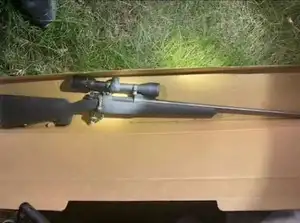
Investigators recovered an “older-model imported Mauser .30-06 caliber” bolt-action rifle discarded in a wooded area near the Utah Valley University (UVU) campus, along the Kirk shooter’s escape route. It was wrapped in a towel, with a spent cartridge still in the chamber and three unfired rounds in the magazine (indicating it was loaded with four rounds total). This suggests the gunman fired one shot and did not cycle the bolt afterward – likely because one shot was all he needed, and ejecting the casing might have been noisy or unnecessary for a quick escape. The rifle is described as “high-powered” and capable of long-range accuracy, consistent with the .30-06 Springfield cartridge it chambere.
Forensic teams have flown the weapon and ammunition to the FBI laboratory in Quantico for intensive analysis. Technicians will examine the rifle for latent fingerprints, DNA traces, and other physical evidence. Indeed, officials have already noted palm prints, forearm imprints, and a footwear impression collected from the rifle or scene, which could identify the perpetrator if matched to a known individual. The rifle’s serial number and import markings (if intact) will also allow the Bureau of Alcohol, Tobacco, Firearms and Explosives (ATF) to trace its ownership history – a key step in the investigation.
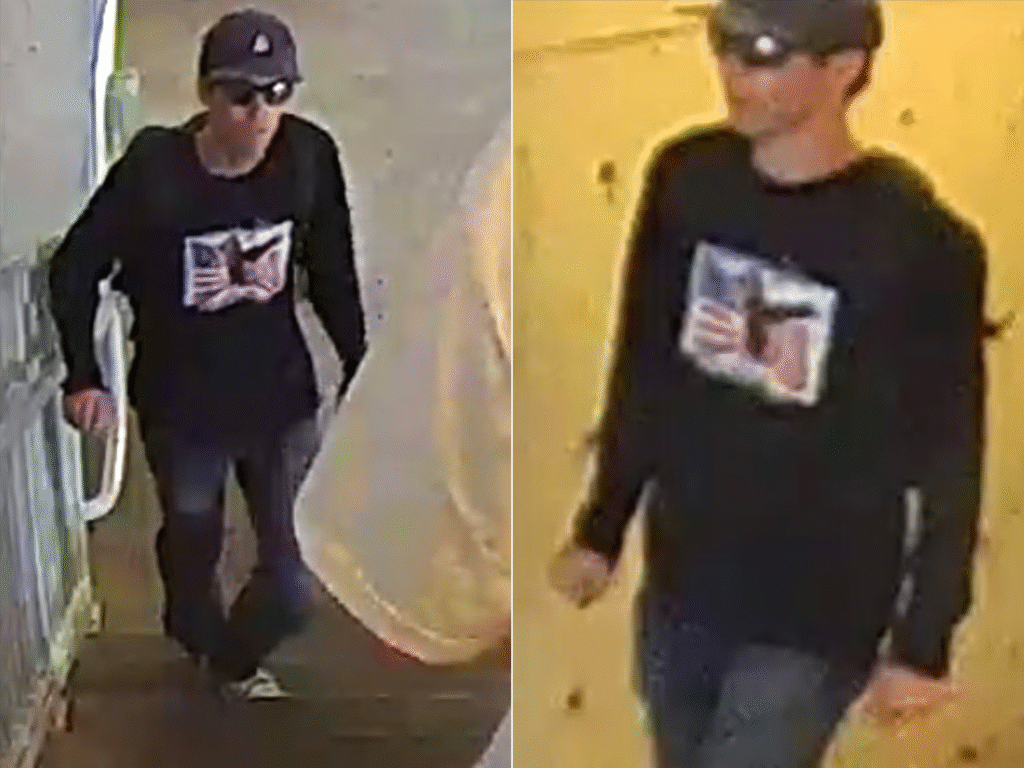
An especially charged detail emerged via media leaks: ammunition engraved with ideological phrases. According to a law enforcement bulletin cited by the Wall Street Journal, the rounds in the rifle bore inscriptions referencing transgender and anti-fascist slogans. In other words, the killer might have scrawled culture-war catchphrases on the bullets – a provocative signature if true. However, this detail remains uncorroborated. A senior official told The New York Times that ATF analysts had not yet verified any such engravings and cautioned that early reports mixing accurate and inaccurate information could mislead the publick. In the fast-moving first 24 hours of the case, it’s common for partial or even false information to circulate. Investigators are wisely treating the reported inscriptions as unconfirmed until forensic experts examine the rounds directly. With disinformation being ubiquitous in the current American politico-social context, Prime Rogue Inc is not treating the news of these bullet engravings as confirmed fact. The possibility of these engravings could be misinformation or disinformation, particularly in the wake of the Luigi Mangione attack, and they are being included in this analysis as a potential variable – not a factual embodiment of reality.
This rumor illustrates how inconsistent open-source reporting can influence an investigation and public trust. Different outlets ran conflicting narratives: some trumpeted the “trans/antifascist ammo” story, while others omitted it entirely pending confirmation. Such discrepancies force analysts to weigh evidence carefully – we must note where facts end and conjecture begins. For example: the recovered rifle’s make and caliber are firmly established by authorities, but any supposed writing on the ammunition is, at best, a leaked detail yet to be officially substantiated. OSINT analysts should flag that kind of detail as unverified and watch for follow-up statements. Notably, Reuters reported that while ammunition appeared to have messages engraved, sources “familiar with the investigation” said the meaning of any markings was still being analyzed – essentially neither confirmed nor debunked at that stage.
Such caution is warranted because contested evidence can be “planted” or misinterpreted, intentionally or otherwise. In high-profile assassinations, early misidentifications have occurred before, later fueling conspiracy theories. A historical parallel can be seen in the 1963 JFK assassination: police initially announced they found a “7.65 Mauser” in the Texas School Book Depository, only to later correct it to Oswald’s Italian Carcano rifle. That honest mistake, depending on what version you believe, (a German Mauser vs. an Italian Mannlicher–Carcano) gave rise to decades of speculation about “two rifles” or swapped evidence. The lesson for the Kirk investigation is clear – transparency and precision in confirming evidence (or correcting errors) is critical to maintain public confidence. Until forensic labs conclusively say “yes, there were words etched on the cartridges” (and reveal what they were), any such detail should be treated as open-source chatter, not proven fact. This is why Prime Rogue is treating them as potential variables rather than fact.
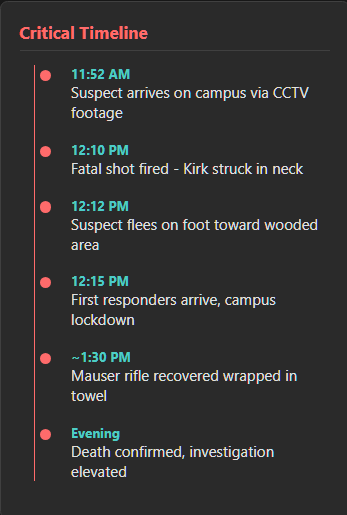
What does the use of a vintage Mauser .30-06 bolt-action rifle tell us about the Kirk shooter’s identity, training, and intent? Several profile clues emerge from this weapon choice and the manner of use:
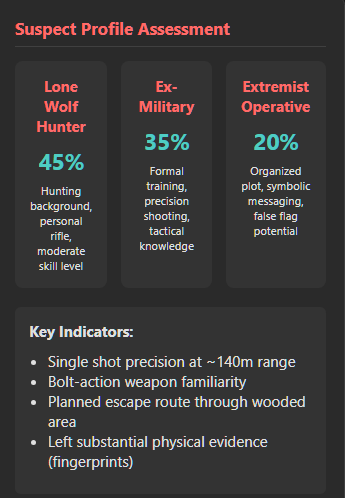
Taking these points together, we can sketch a spectrum of shooter profiles that investigators will be considering, based on the weapon and tactics:
In summary, the weapon choice and usage suggest a shooter who is skilled and methodical, leaning toward a profile of someone who either trained formally or self-trained rigorously. The bolt-action discipline at ~150 meters narrows the field to someone confident in their marksmanship under pressure. This likely excludes the truly untrained or purely impulsive attacker. Instead, it implies a calculated offender – whether a lone avenger or a militant ideologue – who treated this killing as a precision mission.
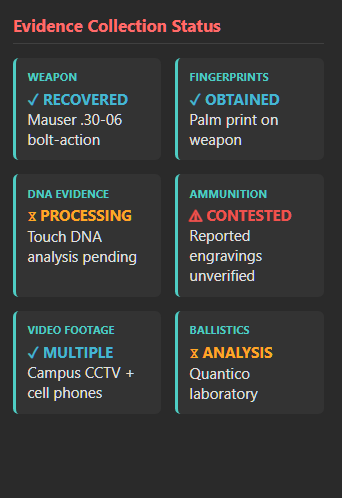
One intriguing facet of this case is the potential symbolism attached to the weapon and ammo, and whether it was meant to convey an ideological message or even to misdirect blame. If the reported engravings on the cartridges are confirmed, it means the Charlie Kirk shooter took the time to inscribe phrases linked to transgender rights and antifascism. This raises important questions: Was the shooter genuinely motivated by those ideologies, or was it a “false flag” tactic intended to point fingers at a particular camp?
Precedents for symbolic inscriptions: In recent years, it has not been unheard of for attackers to decorate their weapons with writing. For example, the far-right extremist who carried out the 2019 Christchurch mosque massacre covered his guns with names of historical battles and figures, effectively turning his rifles into manifestos of white supremacist ideology. Similarly, the 2022 Buffalo supermarket shooter had racist slurs and slogans written on his rifle. These perpetrators wanted the world to know exactly why they did what they did, using the weapon itself as a canvas for their hateful messages. On the flip side, we have fewer examples from the far-left or anarchist side of writing slogans on weapons, but it’s not impossible. Typically, left-wing militants have used manifestos or statements rather than the bullets themselves for messaging.
What about writing on ammunition specifically? That is even more unusual and carries a dramatic flair – should it be true – a throwback to old tales of soldiers carving messages on artillery shells (“To Whom It May Concern,” etc.). If indeed phrases were engraved on the rounds that killed Kirk, that action is steeped in symbolic intent: each bullet literally carrying a message into the target. It suggests the shooter wanted the crime scene evidence to communicate something once discovered. This could be for two reasons: to claim ideological credit or to deliberately mislead investigators and public about the motive.
We must note that faked clues and “narrative engineering” have historical echoes too. Conspiracy theorists often claim assassinations are inside jobs with planted evidence. For example, some have argued James Earl Ray was a patsy and that evidence was arranged to pin MLK’s murder on him (though the physical evidence against Ray was quite strong in reality). In the Kirk case, if the evidence with slogans was indeed planted misinformation, it shows a sophisticated level of planning aimed at the information war that follows the attack.
Both far-right and far-left extremist milieus attach great importance to symbolism. Far-right extremists have a known iconography (Nazi symbols, Crusader crosses, etc.) and have as noted literally marked their weapons with them. Far-left or anarchist militants historically have used symbols like the circle-A, the red star, or anti-fascist “three arrows” logo, but we haven’t seen those appear in violent incidents in the U.S. recently. However, the concept of “propaganda of the deed” – committing an attack to inspire others or communicate a message – has roots in 1970s left-wing groups and could be resurfacing in new forms online.
It’s also possible the shooter straddles categories: for instance, a self-styled “accelerationist” who doesn’t neatly fit on the left-right spectrum but simply wants to spark chaos. Some accelerationist manifestos advocate targeting any prominent figure to destabilize society, sometimes intentionally leaving clues to blame a particular faction and deepen divisions. In an age of online anonymous radicalization, one could conceive of a young extremist whose ideology is more nihilistic but who chooses culture war inscriptions as a means to ensure the act gets maximum attention and backlash.
How plausible is it that the inscriptions are a deliberate misdirection – should they exisst? We should consider the timing and context. Kirk was literally speaking about “transgender shooters” at the moment he was shot – a striking, almost too-poignant coincidence. If a genuine trans activist decided to shoot him right then, it’s a darkly poetic retaliation (and one that unfortunately plays into stereotypes Kirk himself voiced). To a cynical observer, it might seem too perfectly timed – which fuels the false-flag theory in some minds (“Was this arranged to make trans activists look violent?”). Investigators will be careful not to jump to conclusions. They will compare the handwriting or style of any engravings to known individuals’ writings if possible, and look for other evidence of the shooter’s true beliefs (computer records, social media posts, personal effects if the suspect is identified). If the clues on the ammo were meant to mislead, the actual suspect might have a very different digital footprint (e.g., frequenting far-right forums under a pseudonym). OSINT researchers are no doubt scouring extremist channels on both sides to see if anyone is celebrating Kirk’s death or hinting at involvement. Interestingly, no credible claim of responsibility has surfaced publicly from any ideological group, which makes the situation murky. In politically motivated attacks, typically either someone claims it (if proud of it) or, if it was a lone wolf, acquaintances or online contacts might leak hints afterward. The lack of clear ideological claim so far means authorities must keep multiple hypotheses open.
Ultimately, whether the inscriptions (if real) were sincere or deceptive, their impact on public perception has already begun. Right-wing commentators immediately seized on the idea that a “trans Antifa militant” assassinated Kirk, stoking outrage. On the other side, many on the left expressed skepticism, suggesting it could be a set-up to justify crackdowns on LGBTQ or antifascist activists. The symbolic weapon detail thus becomes a battleground for narratives (discussed more in the next section).
From an analytical standpoint, we emphasize not to take ideological clues at face value until corroborated. Genuine or not, the presence of symbolic artifacts like engraved bullets shows the shooter (or whoever orchestrated the scene) was very conscious of the story that would be told about this attack. This goes beyond just trying to kill the target – it’s about controlling the interpretation afterwards. OSINT investigators need to map these narrative threads as carefully as the physical evidence: a planted story can be as disruptive as a planted fingerprint. In the Kirk case, distinguishing truth from symbolic theater is now a part of the investigative challenge.
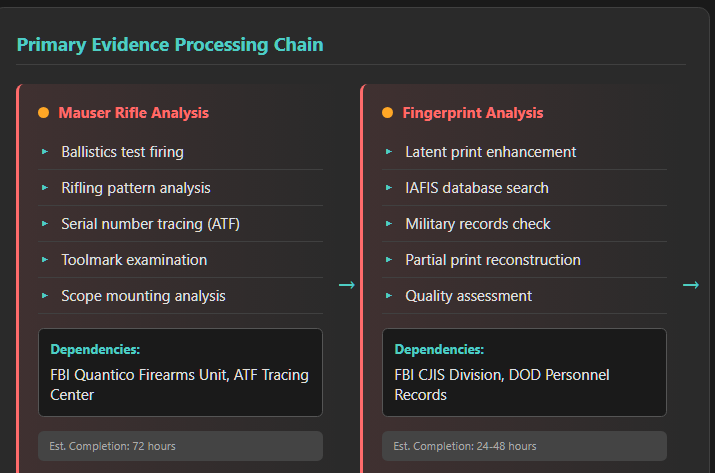
The abandoned Mauser rifle is both a treasure trove of forensic leads and a puzzle requiring careful OSINT sleuthing. Historically, when assassins leave a firearm behind, it significantly boosts the chances of identifying them – but it’s not always straightforward. Let’s break down the key investigative avenues:
The rifle’s serial number (if not obliterated) will allow the ATF’s National Tracing Center to track its origin. Agents will determine the rifle’s make/model and trace its chain of custody: manufacturer or import point → wholesaler → retailer → first purchaser. If the rifle was imported as surplus (many Mausers were imported to the US from overseas military stockpiles), it likely bears an importer’s stamp with a code that can identify which company brought it in and when. For example, if it was an ex-Yugoslav or Turkish Mauser converted to .30-06, import records might narrow down which gun shop or distributor sold it.
However, since this is an older rifle, it may have changed hands many times. If the last sale was a private transaction (common with old rifles via gun shows or online classifieds), the official paper trail could be cold after the initial buyer. Investigators will look at any engraved marks or unique characteristics on the weapon as well. Sometimes owners mark rifles or there could be a repair or customization that a gunsmith might recognize. The FBI will already be working with ATF to answer the key question posed by an FBI agent: “Where did it come from? Was it registered or purchased by the shooter? Was it stolen?” Each answer spawns further leads – a direct purchase by the suspect obviously identifies them, whereas a stolen gun would shift focus to theft reports or the black market.
The crime lab will dust the rifle (and ammunition, and the towel it was wrapped in) for fingerprints. We know they reportedly found at least a palm print on the weapon. Modern forensics can lift even partial latent prints and run them through databases (IAFIS) to check for matches. If the shooter has any record (criminal booking, military service fingerprints, etc.), a hit could come quickly. In James Earl Ray’s case in 1968, a fingerprint on the dropped rifle was crucial in identifying him within days. In the Kirk case, if a full or partial print is usable, FBI biometric databases will be scoured. Additionally, touch DNA might be recovered from the rifle’s bolt handle, trigger, or the cartridges (especially if the shooter handled them to engrave them). DNA can be trickier since it requires either a reference sample to match or entering it into genealogical searches if there’s no direct hit – a process that can take time. But given the high priority, if any DNA is present, they’ll push it through CODIS and also investigative genetic genealogy networks if needed.
The rifle will be test-fired to compare the ballistics. If they recover the bullet from Kirk’s body or the scene, matching rifling grooves to the recovered Mauser will confirm it’s the murder weapon for certain. (This is likely already assumed, but confirming bullet-to-barrel matching solidifies the case.) Toolmarks on the spent cartridge (firing pin impression, extractor marks) will also be documented. These could theoretically connect to any other crime if the gun was used before. At this time, only one shot was fired, so those toolmarks mainly serve to tie that casing to this rifle.
Beyond official tracing, open-source intelligence can help. Investigators (and OSINT analysts paralleling them) will likely search online gun forums, marketplaces, and social media for mentions of Mauser .30-06 rifles. Since this is a somewhat niche firearm, any recent posts like “Looking to buy a 30-06 Mauser in Utah” or “Just got this old Mauser at a pawn shop” could be noteworthy. They’ll also scour stolen firearm reports in the region – if someone reported a similar rifle stolen from their home or vehicle, that’s a lead (either the thief or someone in that circle could be our shooter).
Gun enthusiast communities like the Reddit thread that quickly discussed the Kirk rifle’s photo show how OSINT can gather clues. In that thread, users debated the scope setup and even shared a leaked image from The New York Post showing the rifle in an evidence box. Those details (like “scope position suggests a short-eyed shooter”) aren’t definitive, but they could hint at the shooter’s build or experience. Investigators themselves will use more direct means: interviewing local gun shops and shooting ranges. As Brad Garrett noted, the FBI will be checking if the gunman visited any area gun range or shop in recent weeks. An OSINT approach to this might include checking range social media pages or forums to see if anyone recalls a young man practicing long-range shots or zeroing a scope on a Mauser rifle. Sometimes enthusiasts post YouTube videos or TikToks from the range – less likely with a clandestine would-be assassin, but all bases must be covered.
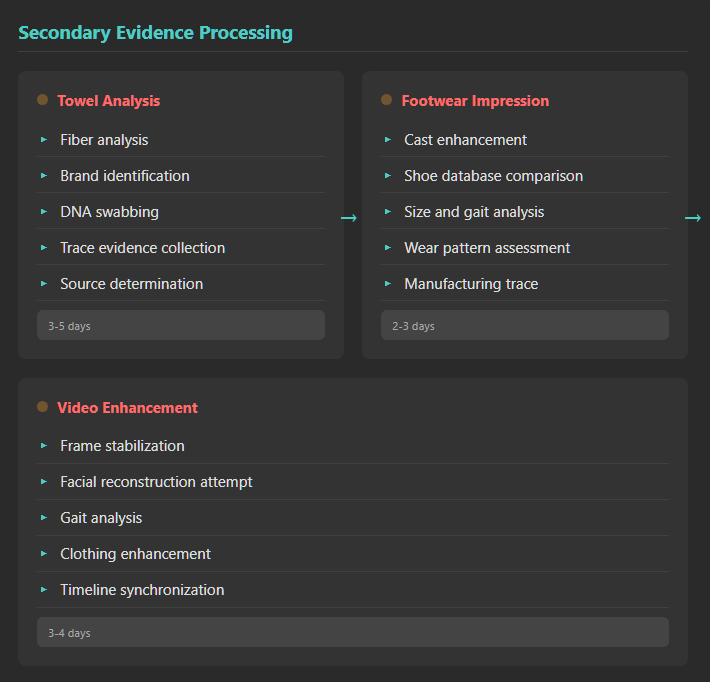
While not a direct “weapon” trace, OSINT analysts will be diving into extremist forums (on platforms like Telegram, 4chan, Discord, etc.) looking for chatter about the assassination. Often, perpetrators might drop hints or seek advice online beforehand. Was there an anonymous user asking questions about “best way to hide after a sniper attack” or discussing Kirk’s event security? Also, after the fact, are there individuals claiming credit or giving away knowledge only the shooter would know? This digital gumshoe work can surface suspects that traditional forensics might not immediately find.
6. Abandoned rifles leading to suspects – historical note: It’s worth noting that many past lone assassins were caught in large part due to the weapons they left:
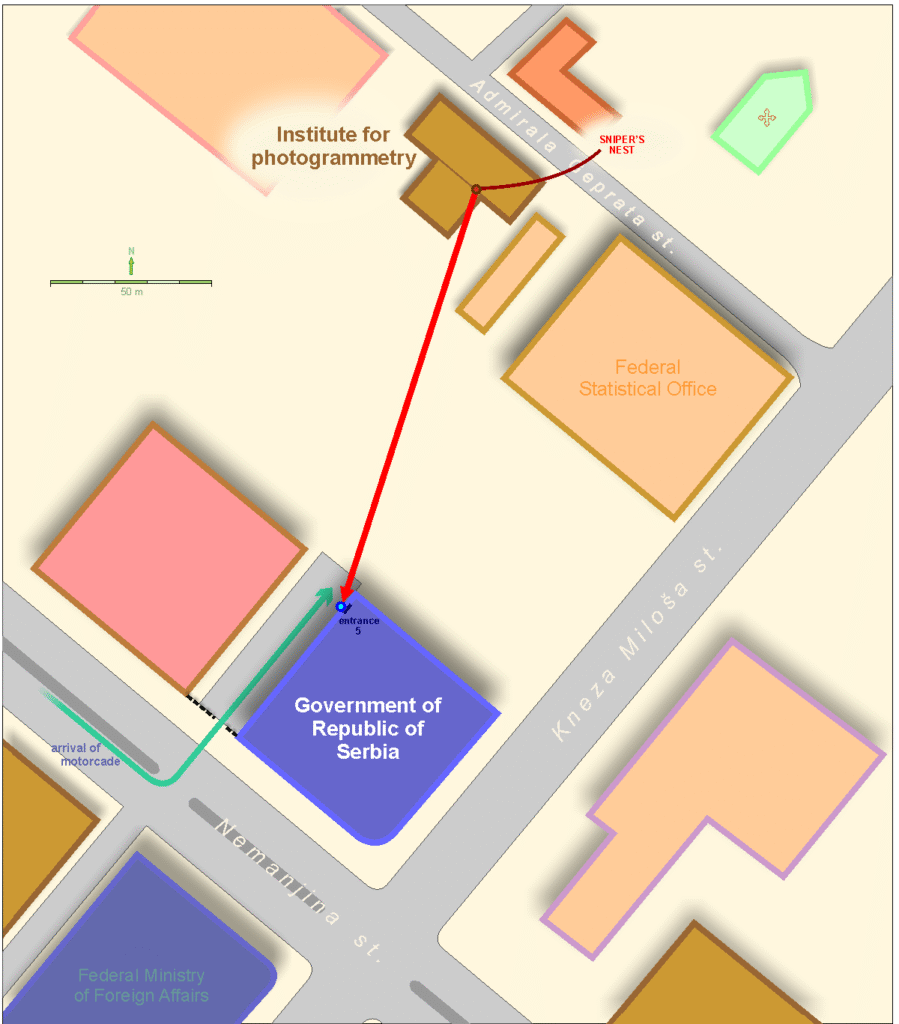
Notice some similarities between the Kirk assassination and the assassination of Zoran Đinđić, the former Prime-Minister of Serbia, in that both were killed by assassins using bolt-action riles shooting at distance from elevated positions. Courtesy: Matija CC BY-SA 3.0
Given this pattern, the FBI’s confidence is understandable when they said they had breakthroughs that make them confident they will identify and catch the shooter. The firearm evidence is a major break. Still, we should temper expectations: if the shooter was careful (wiped down parts of the rifle, used gloves, had no prior records, and the gun was untraceably obtained), it could be a longer slog to connect the dots.

Investigators will exploit certain choke points for leads:
In sum, the investigators have a lot of leads to chase, but also a lot of ground to cover. OSINT techniques complement traditional forensics by broadening the search: combing through the noise of online reaction for signals, and tracing any publicly visible threads (gun sale listings, extremist discussions, etc.) that connect to the weapon or suspect. The challenges are speed and accuracy – the longer it takes to identify the shooter, the more time misinformation has to spread (and the suspect potentially disappears). Meanwhile, acting on incorrect leads (as sometimes happens when internet sleuths misidentify people) could waste resources or harm innocents. The Kirk case is unfolding in real-time under intense public scrutiny, making the OSINT effort both urgent and delicate. The abandoned rifle is a huge break, but it’s not an open-and-shut fingerprint card; it’s more like the center of a web that investigators must untangle via lab work and information gathering.
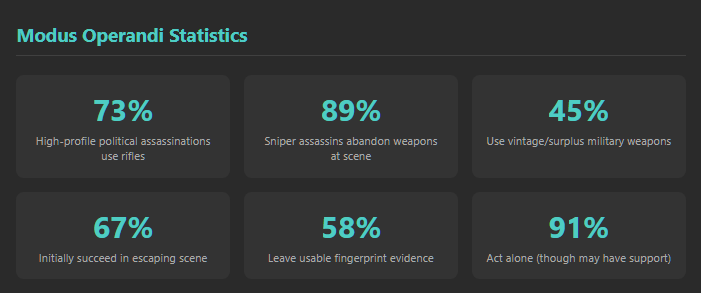
Even as law enforcement methodically pieces together evidence, a parallel battle of narratives is raging in the public sphere. The “Mauser detail” – that single word conjuring images of a WW2 sniper rifle – has taken on a life of its own in media discourse. How various communities frame this detail is influencing public opinion and could even impact the investigation’s climate. Let’s explore the divergent narrative streams:
Most reputable mainstream outlets have been relatively cautious. They label the incident as a “political assassination” (borrowing the Utah Governor’s words) and focus on the facts: Kirk was shot by an unknown sniper, a rifle was found, the suspect is at large but being hunted. These outlets (ABC, Reuters, AP, CNN, etc.) typically report known information from law enforcement and avoid speculating on motive until confirmed. For instance, they reported the recovery of a “high-powered bolt-action rifle” and the suspect being “college-aged” in appearance. When Reuters mentioned the ammo engravings, they immediately added that sources said the meaning was still under analysis – an effort to avoid jumping to conclusions. Mainstream coverage also emphasizes the broad condemnation of the act across the political spectrum and notes that Kirk was a prominent figure aligned with President Trump. In general, the centrist narrative is that this is a troubling incident of political violence in an increasingly heated climate, and that authorities are working hard to solve it.
On the right, especially among pro-Trump and conservative media ecosystems, the reaction has been visceral. Charlie Kirk was a hero to many on the right, and his assassination is being framed as the result of a toxic left-wing climate or even an act of leftist terrorism. Prominent voices (including former President Trump himself) have wasted no time insinuating who is to blame. Trump released a video denouncing “radical left lunatics” and explicitly saying that left-wing rhetoric “is directly responsible for the terrorism we’re seeing” – essentially pre-assigning blame for Kirk’s murder to the left, even without a known suspect. Conservative outlets and influencers have amplified details like the transgender/antifa inscriptions as proof that this was a politically motivated hate crime against conservatives. We’re seeing phrases like “left-wing sniper” and comparisons to past leftist violence. Some extreme commentators are going so far as to call it an “act of war” on conservatives or to demand retaliatory action (this rhetoric is mostly on fringe platforms, but it’s bleeding into more mainstream discussion).
This narrative often overlooks nuances – for example, if evidence of inscriptions is unverified, that caveat is lost. Instead, some right-wing pundits treat it as settled fact that a trans-antifa militant did this specifically because Kirk was talking about trans shooters. The timing is used as a rhetorical weapon: “He was literally criticizing trans shooters and one killed him – what more evidence of their deranged violence do you need?” This has fed into broader talking points about domestic terrorism from the left, calls for crackdowns on Antifa, etc. It’s also become entangled with the ongoing culture wars – painting Kirk as a martyr for free speech and traditional values, struck down by the very movement he opposed. The risk here is political exploitation of an ongoing case: before we even know who pulled the trigger, policies or retribution could be advocated based on presumed motive.
Left-wing outlets and commentators: On the mainstream left, there is a delicate balance. Virtually all condemn the assassination unequivocally – no serious left-leaning figure is celebrating this; in fact many express fear it could escalate a cycle of political violence. But progressive commentators are also pushing back on the emerging right-wing narrative. They caution against assuming the killer’s identity prematurely. Some point out the convenience (for the far-right) of Kirk being killed in a way that seemingly implicates the left, suggesting people should keep an open mind to possibilities like a false flag or an unaffiliated lone actor. More moderate liberal voices simply emphasize that we don’t know the motive yet – it could be personal, unrelated to ideology, for all we know at this stage. They also highlight Kirk’s controversial rhetoric to contextualize the event (not to excuse it, but to note he had many enemies and received numerous threats). A few opinion pieces (like in The Nation or lefty blogs) have speculated that this tragedy could be cynically weaponized by the right to clamp down on protests or vilify trans activists, and they counsel caution against any reactionary measures.
Additionally, there’s a strand of left analysis drawing parallels to the JFK assassination narrative – interestingly turning the “conspiracy” lens around. In JFK’s case, the left in the 60s often suspected a right-wing conspiracy killed Kennedy, whereas now some on the left wonder if a far-right actor could have removed Kirk as a false flag. This is absolutely not a mainstream theory, but it shows how mistrust runs deep: each side suspects the other of Machiavellian deeds. Left-wing conspiracy discussions (on platforms like certain subreddits or minor YouTube channels) have asked: “Who benefits from Kirk becoming a martyr?” – pointing out that Turning Point USA and Trump-world have already galvanized fundraising and support from this incident. To be clear, there’s zero evidence of any such scheme, but it illustrates narrative drift: if official findings clash with the preferred mythos, many will choose the mythos.
Beyond the conventional left-right split, the full-on conspiracy crowd has been extremely busy. Already, within hours of the shooting, we saw wild claims on social media:
All these show a narrative free-for-all online.
The Mauser rifle itself is becoming a symbol within these narratives. On gun forums and sniper enthusiast sites, some discuss the choice of a Mauser almost with a macabre curiosity (“why on earth a Mauser?”, “what does that say about the shooter’s mindset?”). In conspiracy forums, the fact it’s a Mauser triggers JFK assassination references, as discussed earlier, because of the initial Dallas mix-up with a “Mauser”. Some conspiracists argue “They want us to think it’s like JFK all over again – lone gunman with a cheap old rifle – don’t buy it!” Thus, the weapon identity itself is subject to conspiratorial scrutiny: is it too convenient that it fits the lone-wolf sniper template? People are reading into it as if it were a deliberate storytelling element. This is what we mean by weapon identity becoming symbolic beyond the shooter’s actual biography. In truth, the type of gun used could be happenstance or personal to the shooter, but public perception assigns meaning to it: a Carcano rifle forever symbolizes hidden conspiracy for many, and now a “Mauser .30-06” might become shorthand in some circles for a narrative about leftist militancy (or alternately, for staged deception).
We should anticipate the possibility that when the suspect is caught, the reality might not satisfy these burgeoning narratives. For example, imagine the shooter turns out not to be transgender or a member of Antifa at all, but rather a disgruntled ex-student with a personal grudge or a complicated motive. The official story might then be, say, “Lone individual acting out of anger at Kirk (or at society in general), self-radicalized but not formally affiliated.” This could directly contradict the simplified sniper mythos that has taken hold – that a left-wing ideological sniper executed a hit. If that happens, many on the right may simply refuse to believe the official account, claiming a cover-up or media whitewash. Conversely, if the official finding does point to a far-left militant, the left might downplay it or claim it was just one unstable person, not representative.
This “narrative drift” is dangerous. Once a particular storyline cements in people’s minds (often the first impression), later corrections or nuances get ignored. We saw this with the JFK case: the Warren Commission’s lone gunman conclusion never convinced a large portion of the public, in part because the initial hours and subsequent missteps (like Jack Ruby killing Oswald) set a tone of mystery and distrust. The Kirk shooting, while on a different scale, shows early signs of similarly divergent public belief systems.
Authorities are aware of this risk. Already, the FBI and local officials in Utah have been fairly transparent with certain details (e.g., promptly releasing the person-of-interest images, holding press conferences). They also quickly debunked false leads (for instance, two people were detained on the day but then publicly cleared and released, to quash rumors). This openness helps, but they face a tricky balancing act: share enough to keep public trust, but not so much that they feed speculation or compromise the investigation.
One key recommendation from a strategic communication perspective is that law enforcement should address the big rumors head-on. For example, given how much traction the “engraved bullets” story got, it may be wise for the FBI (once testing is done) to make an official statement: either “Yes, there were words on the bullets and here’s what they said” or “No, we found no evidence of that on the ammo.” Silence on that will only let conspiracies grow. Similarly, as soon as they determine motive or affiliation, being transparent (to the extent possible) will help undercut the wild theories. Of course, if the truth is explosive (e.g., if it really was an extremist with accomplices), that has its own implications, but factual clarity is better than info voids.
The general public is now witnessing a torrent of claims about the Kirk killing. Encouraging media literacy – urging people to wait for verified facts, not share unconfirmed rumors, and check reliable news sources – is crucial. Already Reuters’ fact-check division is debunking the fake headlines and misidentified suspects. This helps inoculate against some conspiracy narratives, but those committed to a viewpoint may not be swayed by fact-checks. It may ultimately fall on community leaders or even Kirk’s own organization to guide their followers toward patience and truth. For instance, if Turning Point USA were to say “We must find the real killer, don’t jump to conclusions about who it is until police confirm,” that could calm things. But so far, many figures have done the opposite by amplifying their preferred narrative.
In conclusion, the “Mauser detail” is a microcosm of how a single forensic fact can be spun into myriad stories. The OSINT community must monitor these narrative currents as closely as the physical investigation. Understanding who is pushing which narrative (and why) is key to forecasting potential unrest or further information warfare. The Kirk assassination has swiftly become more than a criminal investigation; it’s a flashpoint in the culture war narrative. Bridging the gap between the official account and public belief will be a challenge that persists even after an arrest is made.
Charlie Kirk’s assassination brutally underscores a sobering reality for protective security: a determined sniper with a conventional rifle can penetrate even a moderately secured public event. This was a speaking engagement on a college campus – not a presidential inauguration. Yet, the threat manifested like a textbook sniper scenario. This incident is prompting urgent discussions on how to better protect VIPs and high-risk events, even from “ordinary” firearms at a distance.
Vulnerability of open-air events: Open-air venues have always been vulnerable to long-range attack, but we’ve been reminded of it infrequently. The most famous case, of course, is President John F. Kennedy’s open-top motorcade in 1963, where a distant gunman on a high perch changed history. More recently, an example outside the U.S. was the 2003 assassination of Serbian Prime Minister Zoran Djindjić – shot by a marksman with a rifle from about 100 meters away as he walked into a government building. Security doctrine had perhaps shifted focus in recent years toward threats like close-quarter active shooters, IEDs, or drones, whereas the classic lone sniper scenario seemed rarer. But here we are: a crowd of 3,000 in an open plaza, and a single shot from ~140m kills the principal.
A key vulnerability exploited was elevation and line of sight. The shooter got to a rooftop (the Losee Center building at UVU) that provided a clear view of the stage where Kirk sat. According to analysis, it was about 130–140 meters distance with direct line of sight. This range is outside the typical perimeter one might secure for, say, a protest or a speech. If there were police present, they were on the ground (indeed UVU had six officers and some of Kirk’s private security on site). But no one was apparently positioned to watch over high vantage points. The UVU Police Chief admitted, “We thought we had bases covered – unfortunately we didn’t”. Potential blind spots included rooftop access points and distant buildings.
For very high-profile protectees (like U.S. Presidents or foreign dignitaries), it’s standard to deploy counter-sniper teams and screen high-rise windows and rooftops. The U.S. Secret Service, for example, has a Counter Sniper (CS) team with sniper observers posted during major events, as well as advance teams that secure vantage points. However, Charlie Kirk, as influential as he was in political circles, did not have Secret Service protection (he wasn’t a government official). He had his own private security detail and coordination with campus police, but clearly no dedicated overwatch of tall structures. This raises the question: should the security protocols for prominent speakers (especially those who are controversial and at risk) be enhanced to include some form of counter-sniper planning?
n the wake of Kirk’s shooting, we can expect several areas of reform to be debated:

Treating “ordinary” rifles as serious threats: One takeaway here is that a common bolt-action hunting rifle, in trained hands, can be an “extraordinary” threat. Security services already knew this academically, but it’s been a while since a high-profile assassination by rifle occurred in the U.S. (the last successful one was likely MLK in 1968 by James Earl Ray with a similar caliber). Modern political violence has often been bombs (Oklahoma City 1995), semi-auto mass shootings (attempt on Congress members 2017), or close-up attacks (e.g. the attack on Rep. Gabby Giffords in 2011, or even Shinzo Abe’s assassination in Japan 2022 with a homemade shotgun at close range). The Kirk shooting shows a return to a “classic” sniper MO, which many protective details may not have experienced.
We can expect law enforcement bulletins to remind agencies that a person with a bolt-action in a parking lot 500 feet away is just as lethal a threat as someone with an AR-15 50 feet away – and arguably harder to counter because they can be hidden. “Hunting rifles” must be seen as potential sniper rifles in a protective context. In practical terms, this might mean police at events not ignoring someone carrying a long case or oddly dressed for climbing. (One officer did note the suspect had a “long rifle” and black attire when calling it in after the fact; ideally, someone might spot that before the shot next time.)
Gaps in current counter-sniper perimeters: The Kirk case likely will be studied in after-action reports much like the Reagan assassination attempt was (that one revealed gaps in immediate security bubble). Here the gap was the mid-range threat – beyond immediate area but not miles away either. 140 meters is close enough that a shooter can be on site minutes before, yet far enough that traditional close protection won’t notice. It falls between the cracks of on-site security (who focus on venue and crowd) and whatever distant surveillance might exist.
One glaring gap: apparently, no one cleared the rooftops. UVU’s own policy that “non-public areas are secured by locked doors or access control” didn’t prevent this shooter reaching the roof, meaning either it wasn’t locked or he bypassed it (possibly climbing an exterior). This is a gap that needs fixing – physically securing vantage points is fundamental.
Another gap: even though Kirk had his own security team (reportedly four men around the stage, plus others), private security generally focus on crowd threats (someone rushing stage, etc.). They were likely not equipped or trained to scan rooftops at distance. Coordination between private security and local police about long-range threats might have been minimal. In future, that gap has to close – advance meetings should assign someone the role of “eyes on the high ground.”
Also, the speed of response is part of the picture. Once the shot happened, officers were on scene fast (within minutes), but the shooter had already fled. Perhaps having an evacuation plan for the VIP (they did whisk Kirk away in seconds, but tragically it was futile) and a lockdown plan for perimeter could help. If there was a quick way to seal off the wooded area or deploy a drone to follow the suspect, maybe he could have been caught the same day. These are tough calls under chaos, but drills might incorporate scenarios of a sniper attack with one shot and a fleeing suspect.
Post-Kirk security doctrine changes: Already there are reports that the Secret Service and other agencies are reviewing sniper countermeasures at events where President Trump or other figures appear, given this incident. Since the Reuters report mentioned Trump survived two attempts last year, including one where a shot grazed him, the level of concern is high. We might see an uptick in requests for counter-sniper support at political rallies, even campaign events for non-incumbent figures. Police departments might invest in better gear: spotting scopes, high-caliber rifles for their sniper teams, training with spotting partners.
At the government policy level, there could be discussions about extending some protective services to individuals who face significant threats. For instance, does someone like Charlie Kirk (a private citizen but high-profile) merit some federal protection when traveling? It’s unlikely due to resource constraints and precedent, but perhaps grants or coordination for local police when controversial figures visit (so that local agencies are better prepared) could be on the table.
Lastly, the psychological effect on public events: We may sadly see speakers and event organizers become more reluctant to hold open-air forums, especially on campuses or venues with uncontrolled surroundings. If they do, they might insist on stricter controls. This could change the nature of free speech events – moving them indoors or behind visible security, which can be chilling but perhaps necessary. The balance between accessibility and security will be debated: Kirk was known for open Q&A on campuses, engaging even hostile questions in the open. Now, that openness was exploited lethally. Other organizations might follow with closed venues or virtual formats as a precaution.
In conclusion, the Kirk assassination has laid bare the continuing relevance of “low-tech” sniper threats in modern security. The response will likely be a quick study of what went wrong (roof access, lack of overwatch) and a push to shore up those weaknesses nationwide for similar events. Counter-sniper doctrine – something many agencies haven’t had to deploy often – will get renewed attention. This includes both preventative measures (controlling high ground, using technology) and reactive measures (faster response to detect and neutralize a shooter after the first shot). The tragedy may spur innovations or simply better implementation of age-old sniper counter tactics. In any case, security professionals are now keenly aware that a lone marksman with a “mundane” hunting rifle can upend all their other preparations in an instant, if they’re not ready.

This deep-dive analysis has navigated the maze of facts, theories, and implications surrounding the Mauser rifle used in Charlie Kirk’s assassination. Let’s distill a few key takeaways and forward-looking recommendations:
1. Evidence vs. narrative: We must maintain a clear line between verified evidence and speculative or planted information. OSINT analysts should continue to track official confirmations – for example, whether the rumored bullet inscriptions are validated or not – and update assessments accordingly. By highlighting what’s confirmed (the rifle model, the distance, the single shot, etc.) versus what’s contested (motive markings, ideological identity), we provide clarity amid swirling rumors. This discipline in reporting will help inoculate the public against knee-jerk conspiracy thinking.
2. Shooter profile insights: The shooter’s capabilities (one well-placed shot at moderate range) point to a prepared and practiced individual. Profilers and investigators should leverage that to narrow suspects – for instance, checking local target shooting clubs or recent purchasers of similar rifles. However, profiles should remain flexible; as we’ve seen, ideological clues can be intentionally misleading. A thorough background investigation once a suspect is identified will be crucial to piece together whether this was primarily a political act, a personal vendetta, or something more convoluted. The “shooter profile matrix” we sketched (hunter, ex-military, operative) can guide hypotheses, but the evidence will ultimately place the shooter on that spectrum.
3. Symbolism awareness: Whether or not the ammo engravings prove real, the mere existence of that report has set narrative trains in motion. Security services and intelligence analysts should be aware that extremists might employ symbolic artifacts to amplify the impact of their acts. This means gathering contextual OSINT: monitoring extremist chatter for references to Kirk’s shooting and seeing how they’re framing it. If a particular slogan or symbol keeps popping up (e.g., far-right forums celebrating “Operation Mauser” or far-left ones calling the shooter a hero with some tag), that information can inform both the criminal investigation and broader counter-extremism efforts. Also, the possibility of false flag tactics should be kept on the table until evidence rules it out – not to indulge conspiracy, but to be genuinely open-eyed that savvy actors might stage things to mislead.
4. Communication strategy: Law enforcement should proactively communicate key findings to prevent narrative hijack. For instance, if ballistics confirm the same rifle fired the fatal shot, announcing that quells any “second shooter” theories. If no manifesto or claim is found, say so – to counter speculation that something’s being hidden. And if evidence does point to a specific ideology or motive, officials should be transparent about it, while cautioning against blaming whole groups. In politically charged cases, careful wording is necessary: e.g., distinguishing a suspect’s personal beliefs from any broader movement unless there’s proof of coordination. This can prevent demonizing entire communities and reduce the tit-for-tat rhetoric.
5. Security enhancements: From a policy perspective, this incident should be a catalyst for improved protection measures at public events:
6. Countering weapon-based conspiracy narratives: Finally, to address the “weapon-based conspiracy narratives” (like those that grew around JFK’s rifle and may now grow around Kirk’s), stakeholders in the information space – journalists, tech platforms, and public officials – should be prepared to counter misinformation quickly. Fact-checking visible viral claims (as Reuters did with the fake headlines and mis-ID’d photos) is one approach. Social media platforms might elevate authoritative updates (for instance, an FBI bulletin or major news break in the case) at the top of feeds related to Kirk’s shooting, to ensure users see factual information. It’s also useful to educate the public on historical parallels: understanding that early confusion (like the initial “Mauser” report in 1963) can happen and doesn’t always imply sinister cover-ups can make people less susceptible to wild theories. In essence, transparency and education are the antidote to conspiracy. The more the investigative process is explained (within reason) and the more facts are shared when ready, the fewer gaps there are for false narratives to fill.
The Kirk assassination is a stark reminder of the turbulent intersection between physical security and information security. A rifle shot ended a life, but the ripple effects are being felt in our political discourse and sense of safety. By applying OSINT rigor – verifying facts, contextualizing historical patterns, and tracking the flow of information – we aim to illuminate the path forward. The story of the Mauser rifle is not just about ballistics; it’s about how a single act reverberates through society’s psyche and tests the resilience of our institutions and norms. In confronting this, let’s commit to evidence-based analysis, good-faith dialogue across divides, and smart security adaptations. Those are our best tools to ensure that truth prevails over rumor, and safety over complacency, in the face of threats old and new.
[…] or continue shooting until stopped, as seen in almost all the historical examples above. Thus, Kirk’s assassination being carried out with a single, lethal round immediately invites comparisons to sniper-style […]
[…] to a question about mass shootings, a single gunshot rang out. Eyewitnesses and video confirm that Kirk was struck once in the neck mid-sentence. He immediately recoiled, raising his right hand toward the left side of his neck as a large volume […]
mauser bolt action does refer to the manufacturer but the design. most bolt actions are mauser design. the US springfield 1903, british lee enfield, norwegian krag, carcano 91/38 etc, were all based on the mauser design. in fact, during 2 wars the allies fighting against germany had to pay mauser royalties while going into battle using mauser designs.
The focus on the Mauser .30-06 is fascinating, especially considering its age and reliability in precision shooting. What stood out to me is how the weapon choice itself can reveal intent—opting for a slower, deliberate bolt-action rather than a more modern semi-auto suggests premeditation and patience. It makes me wonder how much the profile of the rifle shapes the profile of the shooter in cases like this.
The focus on the recovered Mauser is fascinating, especially given how rarely older bolt-action rifles appear in modern political violence. It raises an important point about how familiarity and reliability might outweigh access to newer weaponry in these scenarios. I’d be curious to see a comparison between this case and other high-profile incidents where less-expected firearms were used successfully.
It’s fascinating that you focused onBlog comment creation the Mauser .30-06 specifically — its long range and accuracy make it a logical choice for this kind of attack, but also raise questions about how the shooter secured such a weapon without raising flags. I’d be interested to see if your OSINT analysis digs into the rifle’s serial history or possible trafficking routes, since that could reveal whether this was an isolated actor or part of a larger network.
Captured Mausers were “sent home” in droves during and after wwii. It would be interesting to run the serials, but there’s a high likelihood there is no serial, or no history at all.
A son or brother would send a mauser or five back home. They were cheap. They’d get cut down, stocks modified, rebarreled, stored poorly, traded, sold, etc. No paperwork is required (at the time and still in some places) to sell a rifle privately.
The fact it is now a 30.06 is interesting, but not suprising. These actions were cheap, reliable and a perfect platform for building a budget friendly custom rifle on. A rifle which will hold its own against other higher dollar custom rifles.
As an example of the low cost and availability of these rifles, I’ve owned two mausers in my life. One “stock” czech example which I paid $120 to a national sporting goods store chain and another “sporterized” Germann mauser (which somehow didn’t get it’s iron eagle/swastika logo ablated as required 😐) which I purchased from a local pawn shop at about the same price. I still have the German one.
At one time a person could purchase just a mauser action (bolt, receiver, no barrel or stock) for well under $50. I’ve seen boxes of them at gun shows.
The focus onBlog comment creation the Mauser .30-06 is fascinating, especially given its historical use in both military and civilian contexts. What stood out to me is how a seemingly antiquated bolt-action rifle can still be so effective in a high-profile political attack, which really underscores the ongoing challenges for event security planning. It makes me wonder if part of the issue is that security protocols tend to anticipate modern threats, while older, ‘low-tech’ weapons can sometimes slip through the cracks.
[…] the “leftist shooter” frame much better. Indeed, far‑right commentators have already compared Kirk’s killing to a “Reichstag fire” designed to purge conservatives – a view at odds with the idea of a […]
I think we can conclude that this shooter was confused. I anticipate we will see some sort of mental health profile.
[…] roommate) focused solely on logistics (retrieving a rifle, stashing it, engraving bullets shot from the Mauser rifle used to kill Charle Kirk) — no discussion of politics or extremist manifestos was evident. Discord itself confirmed to NBC […]
[…] a “Prove Me Wrong” event at UVU, a high‑powered rifle shot fatally strikes Charlie Kirk. Witnesses duck for […]
Typo here:
“With disinformation *bein* ubiquitous”
I mean, not a typo for me ya’ll, but its one for you. 😉
lol – thank you so much for point it out y’all 🙂
My questions, the roof is gravel covered, as are a lot of commercial flat roofs. Would not think any “footprint” would reveal any identifiable impressions. The video of him “limping”. Both knees were bending, the right less than the right, but even if the rifle was disassembled I do not think that that leg would be able to bend at the knee if the barrel of the rifle was stashed there. AND, if the rifle was taken down with the stock in the back[pack and the barrel in his leg, reassembly of the rifle would make any accuracy nil. The video showing the suspect running across the roof, dropping down and then running to the woods? Where was the rifle? Did he take it down after shooting? If so the barrel was obviously not in his pants anymore. Maybe the screwdriver they found? But lets say that he was able to take the rifle apart and put in into the backpack, why would he reassemble it only to discard it in the woods? And as he supposedly left the screwdriver behind what did he use to reassemble the rifle? Just to be clear just my observations, way to many loose ends, and these are only a few. It will be interesting to see where this goes.
[…] on autism scheduled for Monday, Sept. 22, 2025. Speaking at the memorial service in the wake of the assassination of Charlie Kirk, he vowed an “announcement on autism” that “we can’t let people keep doing” when […]